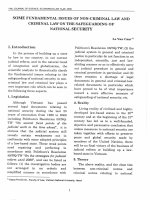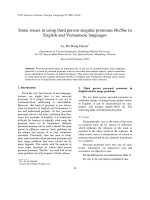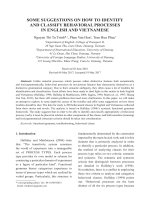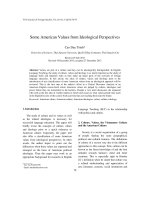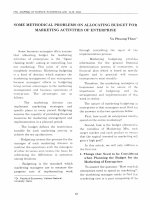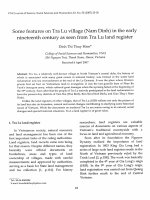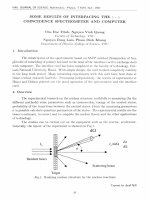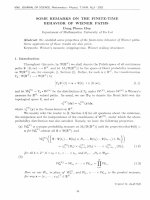DSpace at VNU: Some properties almost - periodic solution of linear differential equations
Bạn đang xem bản rút gọn của tài liệu. Xem và tải ngay bản đầy đủ của tài liệu tại đây (1.76 MB, 4 trang )
V N U . J O U R N A L OF SC IEN CE, M a th e m a tics - Physics. T .X X IỈ, N 0 3 - 2006
S O M E P R O P E R T I E S A L M O S T -P E R I O D I C S O L U T I O N
O F L I N E A R D I F F E R E N T I A L E Q U A T IO N S
T a Q uang H ai
D epartm ent o f Mathematics, Vinh University
A b s t r a c t . Let R be the set of all real numbers, E be a Banach space and B bethe
space of all almost-periodic functions / : R -> E. We consider the equation
x = Ar + /(t),
(1)
where A is a bounded linear operator on E. As well-known that (see [1]), the equation
(1) has an unique solution ip(t) € B for each / GỔ if and only if there existsR(iuj) =
(iu>I - A)~l for all UJ 6 IR, further this solution has the form
J G(t - s)f(s)dsi
oo
v>(t)=
(2)
—oo
where G(u) is the Green function defined by
~ -*-J- for u < 0
“ ) = \i euAP: T + z
“ > 0.
. .
<3)
In this paper, we show the formula and the resolvent of the spectrum of the operator
K defined by the right side of the formula (2).
For any OLG R, by B q we denote the Banach space of almost-periodic functions
whose spectrum belong to a . Let Ka be the restriction of K on Ba, we will prove
that the operator Ka is completely continuous if and only if E is a finite dimensionnal
space and a has no cluster points.
1. Introduction
It is well-known th a t B is a Banach space equiped with the norm ll/ll = sup |/(£ )|.
teR
We denote by p + and p _ the spectral projections, corresponding the spectral set of A,
which lies in a right and in a left half planes, respectively. We consider th e operator K ,
which takes B into itself defined by
/
+oo
G(t - s)f(8)ds.
-oo
Typeset by
19
Ta Q u ang H a i
20
P r o p o s itio n 1.1. (see [1]) I f / ( í ) = Ỵ2 fu {t)e iujt for t G R, where f ư is Fourier coefficient
o f the function / , then
( K f ) ( t ) = j 2 R (i u ’ A W f “eiu)t
f o r a 11 t e R -
(4)
2. M a in r e s u lts
T h e o r e m 2.1. The spectrum ơ( K) of the operator K coincides with the closure o f the
set
ơ = ị - ——- ; Lú G
G ơ( A) ị .
Moreover, the resolvent o f the operator K has the form
R(Z,K) = - I + ^ K ( A + - I ) , z e ơ ( A ) .
(5)
z
z
z
Proof. The first we prove th a t ơ c ơ( K) . If z ị O’(K ), then the equation (z l — K ) f = g
has an unique solution for each / G D By the proposition 1.1, we have
( z l - K ) f ( t ) = Y ^ ( z l - R (iu , A))(t ) fuj(t)eiuJt.
(6 )
Hence, the equation (z l — R (iu , Á ))Ịu = gu has an unique solution for each w G R . This
the operator z I —R(iiJ, A) is invertible. By virtue of the Spectral Mapping theorem(See[2])
we get 2 Ỷ -—“— for £ € ơ( A) therefore ơ ( K) D Ơ. Conversely, suppose th a t z e Ơ then
iuj — £
z Ỷ 0- The spectral m apping theorem implies th a t the operator A + - I is regular. Denote
by s the operator, wich defined by the right side of the form ula (5), then the formula (4)
means
(Sim =
I
z
~ R (iu ,A + Ỉ ) } ( í) /U íý " ‘
z
J
(7)
On the other hand
{ z l - (i u l - .4 ) - 1} = {z{iu)I - Ả ) - \ i L ũ I - A ) - {iu>I - Ẩ ) - 1} - 1
= { iu l - A ) ( i u l - z A - I ) - 1
= -(iu l - A - - I + - I ) ( iu I z
z
z
z
— - I + -(iu l - A z
z
z
(8 )
Combining ( 6 ) and (7) we get
(zl - K)Sf(t) = S(zl - K ) f ( t) =
XL
Since the almost-periodic functions are unique, we have
(.z l - K ) S = S ( z l — K ) = I.
Therefore ơ ( K) c Ơ. The theorem is completely proved.
for all t
e
B.
S o m e p r o p e r tie s e lm o st-p e r io d ic so lu tio n o f ...
L e m m a 2.2.
21
Suppose that E is a finite dimensional space and the set a c R has no
cluster points. Then the collective D o f B is compact i f and only i f B is uniformly bounded
and equally continuous.
Proof. T he “if ’ part is clear. To prove “nly if’ part we consider the continuous real-value
fu n c tio n a ( t ) su ch t h a t a ( t ) = 1 for |£| ^ 1, a ( t ) = 2 for \t\ > 2 a n d a ( t ) is lin e a r for
otherwise t. Set
an (t) = a(ent ) ,
where
en > 0
and
en ->• 0 .
The Fourier transform an of function is integrable and
/
+oo
àn (s)(fi(t + s)ds, If e B
-oo
2
2
is trigonometric polynomial. T he spectrum of this polynomial belong to a n ( - — , — ).
It is well-known th at (see[3]).
\\
(9)
and
llv’-v’nll < ^
+ c<54(2nen),
> 0.
(10)
Since B is equally continuous and by virtue of inequalities (9) and (10), it follows th a t the
collective of polynomial B n = (pn is uniformly bounded i.e B n is compact. Since collective
B is equally continuous and (12), for any £ > 0), there exist number n(c) and if E B such
that IIip — (fn II < e,™ > ^(c).
The set B is compact results from B n is 6-compact net. The lemma is proved.
T h e o re m 2.3. The operator K a is completely continuous i f and only if the space E is a
finite dimensional and a has no cluster points.
Proof. The “if’ part.
Suppose th a t K a is completely continuous.
Denote by D the
bounded supset of E and
v = { / ( 0 = ( i u l - A ) x e iUJ\ X e D } .
Hcnce V is the bounded subset of B a and the collective K av = {xeiuJ\ X e D } is compact
in Dq .
If x l elujt, x 2eiujti
x peiujt is 6-net of K av , then Xi, x 2, X p is 6-net of D. Since B
is compact, the Ritze theorem implies th a t E is a finite dimensional.
Suppose UJO is a cluster point of the set a and {o;n} is the sequence of the diferent
points of the set a , which convergences to (Jo. It follows th a t the sequence -— -— of
ĩu)n £
Ta Q u ang H a i
22
the different spectral points of the operator K a convergences to : — 7^ 0, which is a
ILOq ^
contradition because K a is the completely continuous. Therefore the set a has no cluster
points.
Thus, the “if’ part have been proved. To prove th e ’’only if ’ part we will show
th at the operator K tranfer from the collective of the uniformly bounded function V c B
to the collective of the function, which is uniformly bounded and equally continuous. In
fact, it easily seen th a t this collective is uniformly bounded. We show th a t this collective
is equally continuous. From (3), we have
||G (u)||
f i > 0 ,7 > 0
By (2), (3) we obtain
(11 )
which deduce th a t the collective K'D is equally continuous. By virtue of Lem ma 2.2 the
collective k QV is compact. Consequently, K a is a completely continuous operator theorem
is completely proved.
References
1. Krein. M. H, Lectures on the theory of stability of solutions of diiferential equations
in Banach sapces, Kiev, 1964 (Russian).
3 Dunford. N and Schwatz. J , Linear operators, Moscow, 1982, Vol.l (Russian).
2 Levintan. B.M, Almost-periodic function G IT T L , Moscow, 1953 (Russian).

